RSR's List of the Kinds of Polystrate Fossils
This is the show from Friday, January 24th, 2020
SUMMARY:
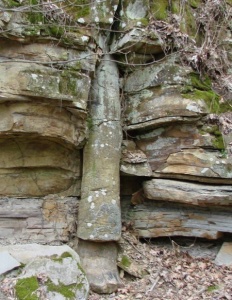
Many have heard about polystrate tree fossils, the thousands of trunks found standing upright through multiple rock layers. (Poly means many, strata means geological layer). Many polystrate fossils (see the list below) are claimed to have been buried in layers that are alleged to typically form over many thousands or even a million years. Areas noted for polystrate tree fossils include:
- Joggins in Nova Scotia
- Sydney, Nova Scotia (260 miles from Joggins)
- Lancashire in England
- Germany's Ruhr region
- Specimen Ridge in Yellowstone
- St. Etienne in France.
Google ranks us #2 in searches for:
list of polystrate fossils.
Trees form one kind of polystrate fossil, and this list, as we will see, is not a list just of polystrate fossils, but it's a list of the kinds of polystrate fossils that exist. Regarding the formation of any kind of polystrate, of course, dead organisms cannot stand for thousands of years waiting to be buried. And characteristically such fossils, as with polystrates trees, show no greater erosion at their top than at their base. So a single polystrate fossil compresses the time it took to lay down its burial strata into a relative brief period.

* Textbooks Skip Polystrates: Creationists claim that geology textbooks tend to omit any discussion at all of polystrate fossils. For example, a 2019 list of the top ten current geology textbooks includes Geology: A Complete Introduction. Yet a Google Books search reveals, "No results found in this book for polystrate." And there's The Changing Earth: Exploring Geology and Evolution published by Thomson Learning with offices in Australia, Canada, Spain, the UK, the U.S., Singapore, and Mexico. "No results found in this book for polystrate." Then there's Physical Geology 16th edition published by McGraw-Hill. "From inside the book, Your search - polystrate - did not match any documents." Those titles are searchable online. It appears there is a lack of interest in polystrate fossils among old-earth geologists. Just like with dinosaur soft tissue, which is the greatest discovery in the history of paleontology, scientists and the science media show a lack of interest in polystrates and what those fossils can tell us about the past. So, because evolutionists lack the scientific curiosity, and undoubtedly that's out of a fear of what polystrate fossils may reveal about the geologic record, it takes creationists to explore them, and explore them we will!
* Evolutionary Explanations for Polystrates: Because geology textbooks ignore polystrate fossils, evolutionary explanations have to gleaned from anti-creation sources and from mainstream geology explanations for strata that contain polystrates. So the old-earth explanations include:
E1 Rapid Sedimentation: The layers burying a polystrate are the exceptions, being deposited during a "rapid rate of sedimentation" (e.g., river flooding burying growing trees; see this at NSCE, the site of Bob's opponent Eugenie Scott). That's the correct explanation, except that evolutionists refuse then to follow those layers to see the extent of the rapid deposition, and thus they close their eyes to the verifiable rapid speed of deposition of the geologic column generally!
E2 Persistent Trees: As at Yellowstone's Specimen Ridge where petrified trees stand through multiple strata that were long claimed to make up 50 successive forests, vertically, each growing and dying out, one on top of another, fifty times. Even though the Nat'l Park Service has removed the exhibit that makes that false claim, nonetheless it shows an inherent polystrate explanation, that trees can remain vertically long enough for the passage for sufficient geologic time to see the rise and demise of multiple layers successive forests.
E3 Persistent Organisms with Rapid Sedimentation: A combination of trees, for example, buried by fast sedimentation, followed by and then slow sedimentation. For example from Talk Origins, they suggest an initial burial in sediments of "several feet" followed by continued slower sedimentation or perhaps additional rapid sedimentation events. Trees don't die and decay instantly, so polystrate trees remained upright through a sequence of fast sedimentation followed by slow sedimentation.
E4 Rare Enough to Ignore: Polystrate fossils are extremely rare and mostly a creationist exaggeration so they can be ignored.

Kinds of Polystrate Fossils:
- Upright trees form only one kind of polystrate fossil, other kinds include...
- Polystrate school of jellyfish fossilized across seven layers allegedly deposited over a million-year period
- 171 (awfully persistent dead) tadpoles in diatoms
- Fossilized end-to-end leaves standing on edge
- Aquatic mesosaur reptile in "annual" varves
- A fossilized whale buried in diatoms
- A fossilized school of whales buried across four strata
-
 Delicate spines radiating through sold rock layers
Delicate spines radiating through sold rock layers
- Nautiloids up to 18 inches in length, thousands buried vertically, for example at the Redwall Limestone which allegedly formed at a rate of about 4,000 years per inch
- A fossilized school of (an allegedly) extinct trout-perch species
- Three-dimensional trilobites in limestone
- Etc. (every one of the millions of fossils that cross strata boundaries)
* Creationist Rebuttals: The old-earth explanations are absurd on their face. Typically, they can't explain a single polystrate let alone the many different kinds of polystrate fossils and the millions of those in existence.
CR1 to Rapid Sedimentation: Even if the earth were billions of years old, secular geologists show an astounding lack of curiosity about polystrates, and by them, which strata could be shown to have been deposited rapidly. Think about the layers that bury such fossils. Those layers don't just extend out only two feet or so from the tree, or from whatever polystrate fossil. We assert, and this could be easily disproved if we were wrong, that the layers that bury and that extend out from each polystrate, as a general rule, go out hundreds or thousands of meters from each fossil, or even 500 kilometers, and more (as with the Redwall Limestone, and so, they extend over thousands of square kilometers). That means that those layers of strata throughout that entire area were deposited rapidly! Shouldn't that interest geologists? And further, some strata layers interleave with neighboring formation layers, like with the edges of some coal seams. So if layers compressed in time by a polystrate fossil happen to interleave with layers of a neighboring formation, then those layers also, in that adjacent formation, had to have been deposited quickly enough to form a polystrate. A single polystrate fossil, potentially, could indicate that an area thousands of square miles had to experience rapid sedimentation. Of course secular geologists, they don't want to know about these polystrates and prefer to believe that such sediments were deposited over millions of years, even if the truth, and the evidence, shows otherwise.
CR2 to Persistent Trees: Trees can't remain upright for thousands or millions of years. Mountains erode faster than evolutionists would have to claim that these trees and nautiloids stood upright, waiting to be buried. And there is often additional evidence that contradicts the slow deposition story, as at Yellowstone where the standard explanation has been falsified in part by our effort here at RSR to expose the truth that the petrified trees there do not have root systems. This shows that these trees were destroyed and transported in a flood event and then waterlogged and sank vertically as flood sediments were settling out of the water. (See that below.) Also, trees are not the only kinds of polystrate fossils. Leaves can't remain upright, that is, vertical, for dozens of years. (See that just below.) A school of fish (below) can't remain frozen in place, all while the allegedly slowly formed strata around them gets deposited layer by layer over years, centuries, millennia, or eons.
 CR3 Persistent Organisms with Rapid Sedimentation: From Talk Origins, so almost not worth responding to.
CR3 Persistent Organisms with Rapid Sedimentation: From Talk Origins, so almost not worth responding to.
CR4 Rare Enough to Ignore: Our RSR list demonstrates that there are many different kinds of polystrates, and when you take all the kinds of polystrates into account, that means that there are many millions, if not billions, of such fossils, showing, like dinosaur soft tissue, that polystrates are not rare but common and appear throughout the fossil record.
* Leaves Buried Vertically in Diatomaceous Rock: Now how about those LEAVES! Leaves? Yes, leaves! There are two leaves, buried vertically, as though standing on edge for thousands of years, while buried by the super-slow deposition of diatomaceous rock! Ha!
Allegedly, diatomaceous earth is evidence of the passage of enormous lengths of time because of its formation from single-cellular diatoms. However, the photo of these delicate polystrate leaves (not unlike an indelicate whale similarly buried in diatoms) demonstrates that diatomaceous sediments can be deposited rapidly.
Then there’s that whale skeleton in a California quarry, uplifted, with its rib cage and other bones buried by diatoms, again, which diatomaceous earth is said to be deposited incredibly slowly!
And speaking of whales, below, we report on the 40 whales buried in Chile!

]

And because jellyfish have no skeleton, as Charles Darwin pointed out, it is rare to find them among fossils. But now, reported in the journal Geology, a school of jellyfish fossils have been found throughout those same seven layers. So, polystrate fossils that condense the time of strata deposition from eons to hours or months, include:
- Jellyfish in central Wisconsin were not deposited and fossilized over a million years but during a single event quick enough to trap a whole school. (This fossil school, therefore, taken as a unit forms a polystrate fossil.) Examples are everywhere that falsify the claims of strata deposition over millions of years.
- A second school of jellyfish, even though they rarely fossilized, exists in another locale with jellyfish fossils in multiple layers, in Australia's Brockman Iron Formation, constraining there too the rate of strata deposition. By the way, jellyfish are an example of evolution's big squeeze. Like galaxies evolving too quickly, galaxy clusters, and even human feet (which, like Mummy DNA, challenge the Out of Africa paradigm), jellyfish have gotten into the act squeezing evolution's timeline, here by 200 million years when they were found in strata allegedly a half-a-billion years old. Other examples, ironically referred to as Medusoid Problematica, are even found in pre-Cambrian strata.

This page began as a segment on RSR's classic List of Not So Old Things at rsr.org/list#jellyfish.]
- Countless trilobites buried in astounding three dimensionality around the world are meticulously recovered from limestone, much of which is claimed to have been deposited very slowly. (See image, RSR's Radtke polystrate trilobite.) Contrariwise, because these specimens were buried rapidly in quickly laid down sediments, they show no evidence of greater erosion on their upper parts as compared to their lower parts.
- 171 tadpoles of the same species buried in diatoms.
- Leaves buried vertically through single-celled diatoms powerfully refute the claimed super-slow deposition of diatomaceous rock.
- Many fossils, including a Mesosaur, have been buried in multiple "varve" layers, which are claimed to be annual depositions, yet they show no erosional patterns that would indicate gradual burial.
- A single whale skeleton preserved in California in dozens of layers of diatom deposits thus forming a polystrate fossil.
- The delicacy of radiating spine polystrates, like tadpole and jellyfish fossils, especially clearly demonstrate the rapidity of such strata deposition.

40 whales buried in the desert in Chile. "What's really interesting is that this didn't just happen once," said Smithsonian evolutionist Dr. Nick Pyenson. It happened four times." Why's that? Because "the fossil site has at least four layers", to which Real Science Radio's Bob Enyart replies: "Ha ha ha ha ha ha ha ha ha ha ha", with RSR co-host Fred Williams thoughtfully adding, "Ha ha!"
polystrate trees:
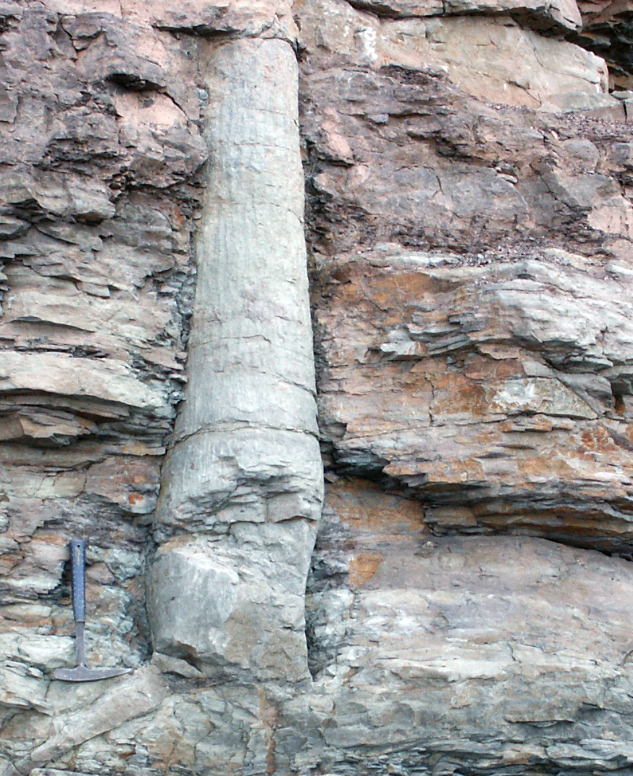
- Yellowstone's petrified polystrate forest (with the NPS exhibit sign removed; see below) with successive layers of rootless trees demonstrating the rapid deposition of fifty layers of strata.
- A similarly formed polystrate fossil forest in France demonstrating the rapid deposition of a dozen strata.
- In many locations, polystrate fossils such as trees span many strata, including famously in the Fossil Cliffs of Joggins, Nova Scotia, which expose sections of 14,000 vertical feet of sedimentary strata, with 49 out of 50 such trees completely lacking their roots, or containing truncated roots, or roots with their rootlets lopped off, indicating that all of these trees were growing elsewhere and transported here in floodwaters.
- These trees lack erosion: Not only should such fossils, generally speaking, not even exist, but polystrates including trees typically show no evidence of erosion increasing with height. All of this powerfully disproves the claim that the layers were deposited slowly over thousands or millions of years. In the experience of your RSR radio hosts, evolutionists commonly respond to this hard evidence with mocking. See CRSQ June 2006, ICR Impact #316, and RSR 8-11-06 at KGOV.com.
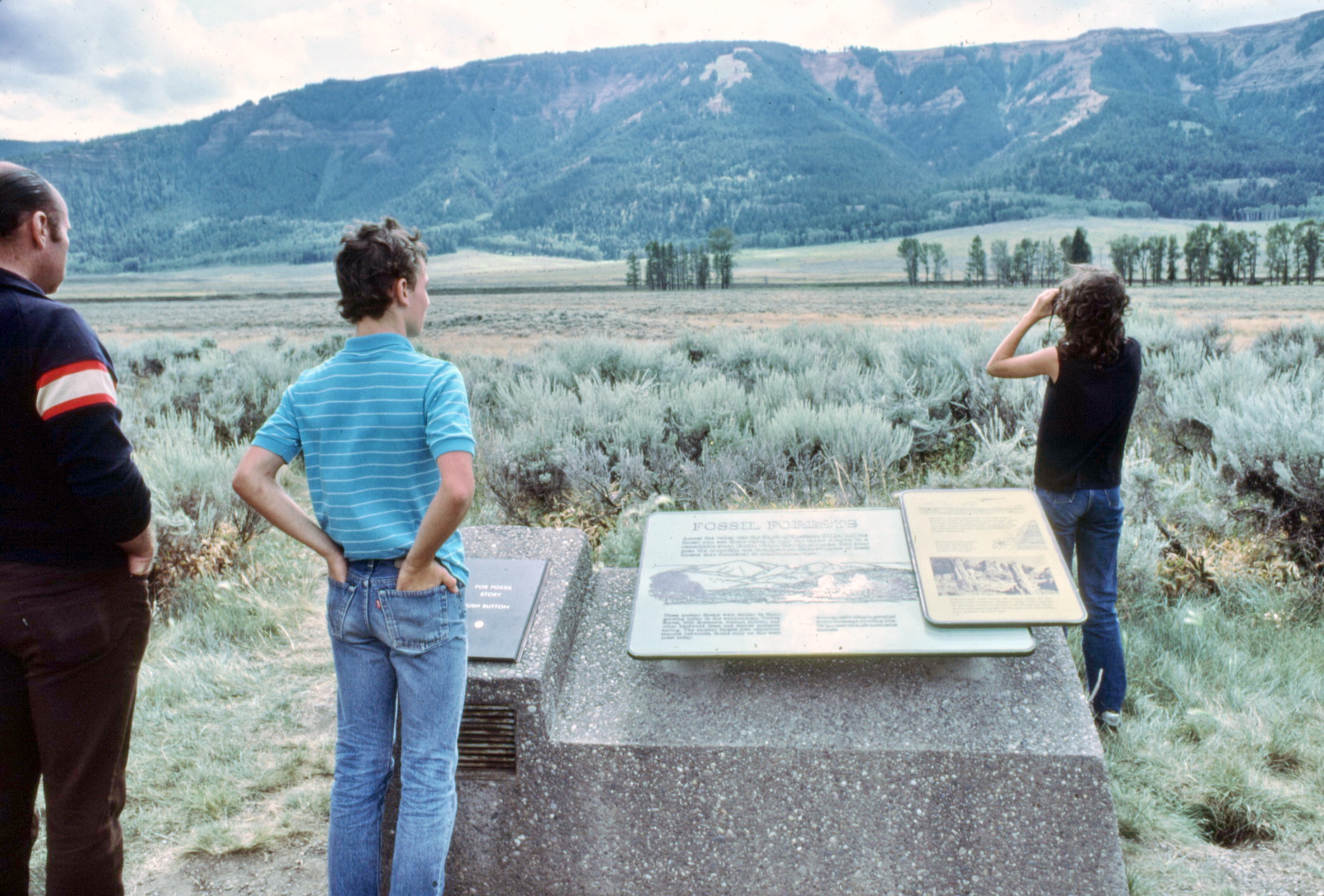
* Yellowstone Exhibit: David Coppedge took these photographs in 1983 in Yellowstone National Park and confirmed to RSR after his 2015 trip that today there are no such signs at Specimen Ridge. Instead, wildlife, etc., exhibits are currently on display there. And near Roosevelt Junction at the fenced-in petrified tree site, the park service presents a sign attributing these tree remains to catastrophic mudflow, which explanation is much closer to reality than their old "successive forests" story. The old, incorrect "Fossil Forest" exhibit claimed that dozens of layers of petrified trees were still standing "where they grew". As explained on Real Science Radio's List of Not So Old Things program, these trees have no root system and were hydraulically transported to their current location. See rsr.org/list#yellowstone. [The second photo below is an RSR composite.]
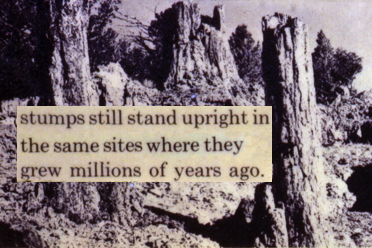
After Bob Enyart's Trading Genesis theistic evolution presentation (see it below) in May 2015 in Malibu, California on the Pepperdine University campus, David Coppedge wrote to Bob Enyart at Real Science Radio:
"The book Roadside Geology of the Yellowstone Country by [geology professor] William J. Fritz (1985, 6th printing 1994), on pp 25-26, also talks about the change. He says, 'When I visited the Mount St. Helens area shortly after the eruption, it was just like Yellowstone!.... Both the mudflows and the appearance of the trees is identical.' (p. 25). On page 26, though, he points out differences between the two sites. Nice to meet you in person today [Bob]."
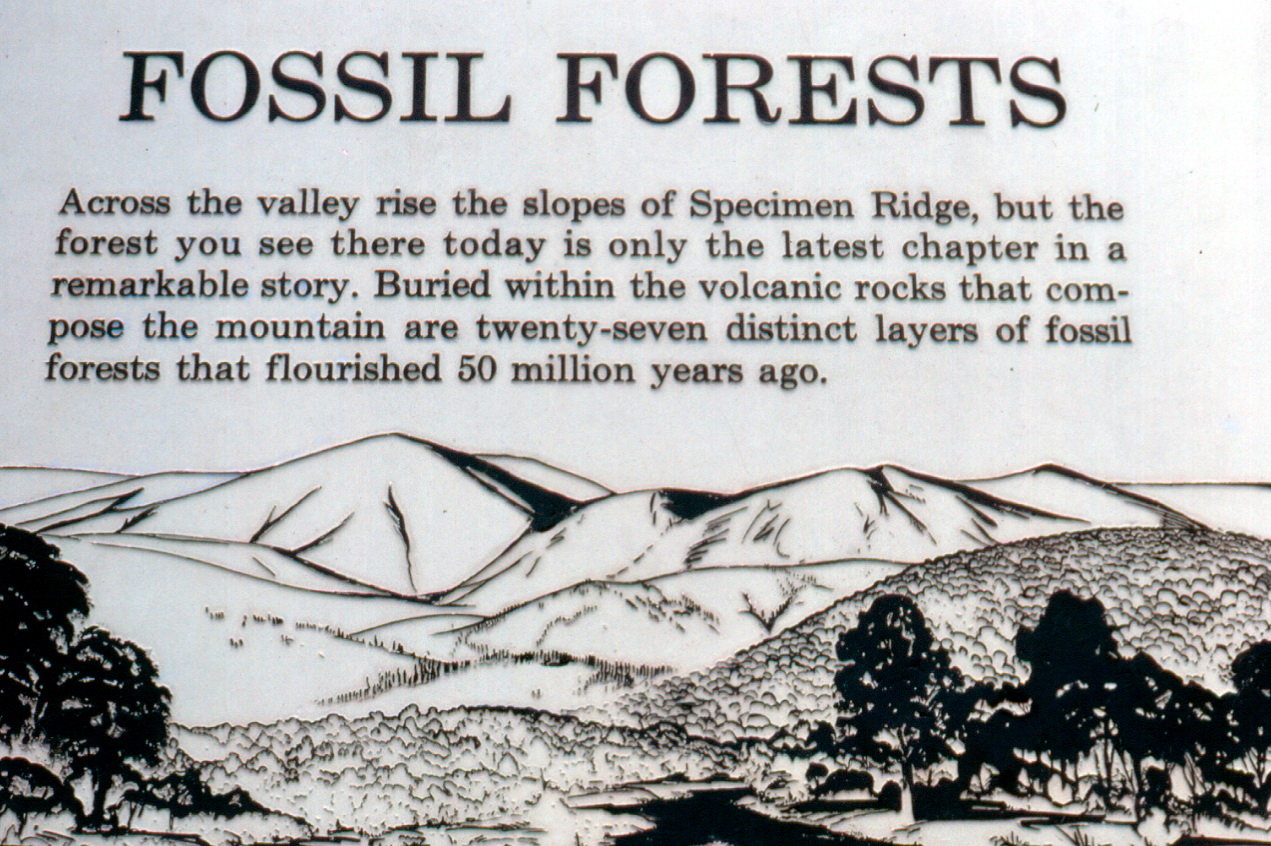

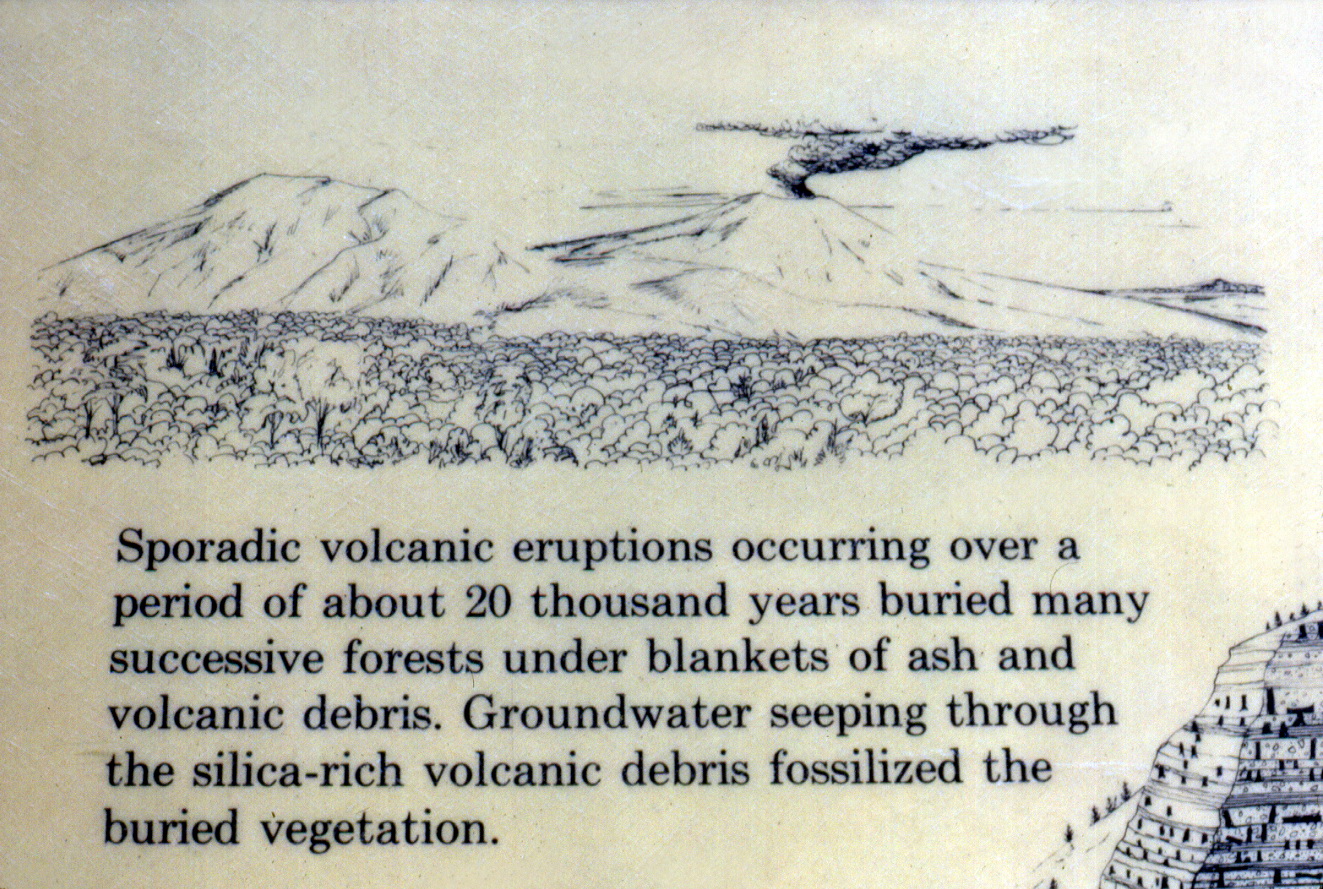
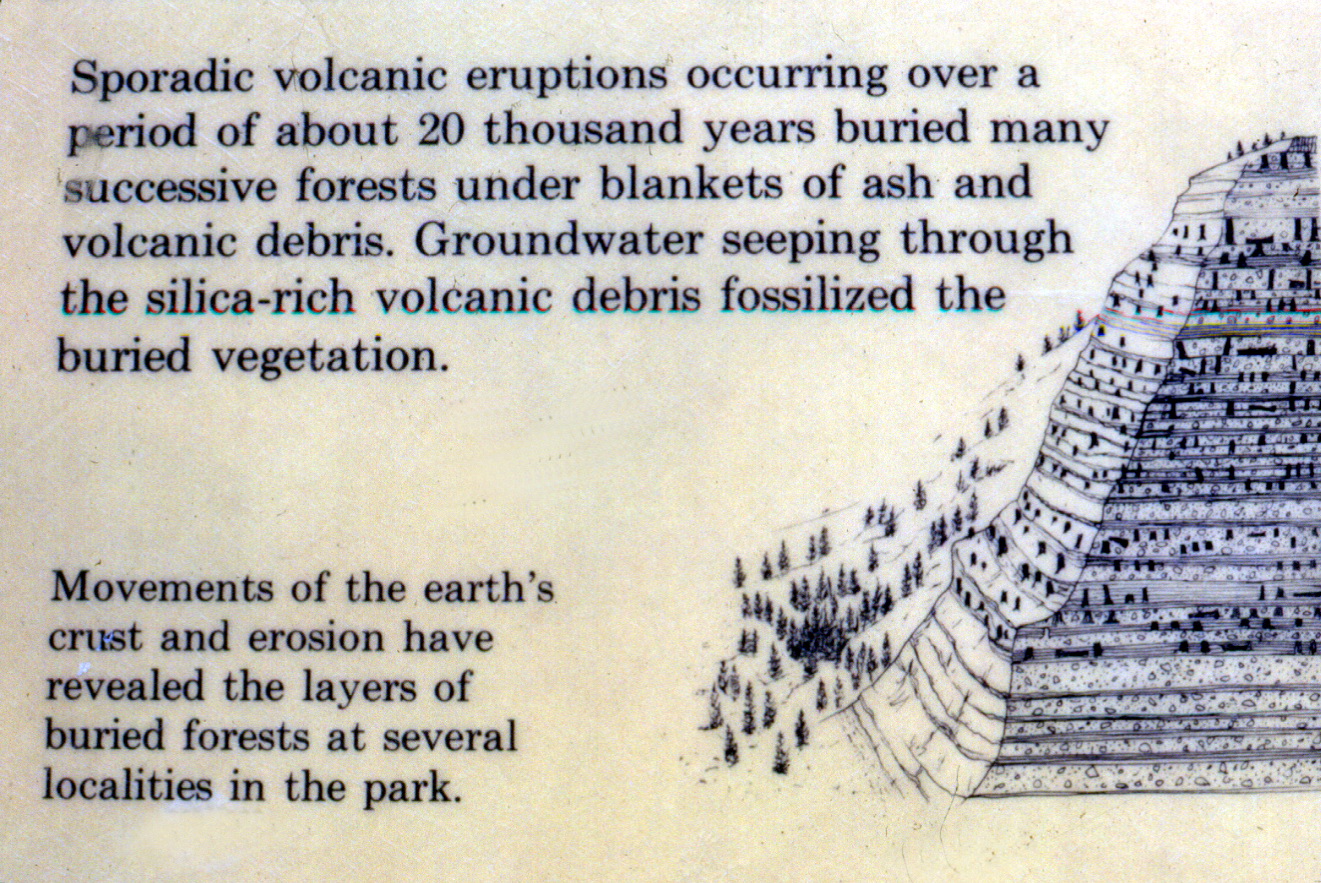
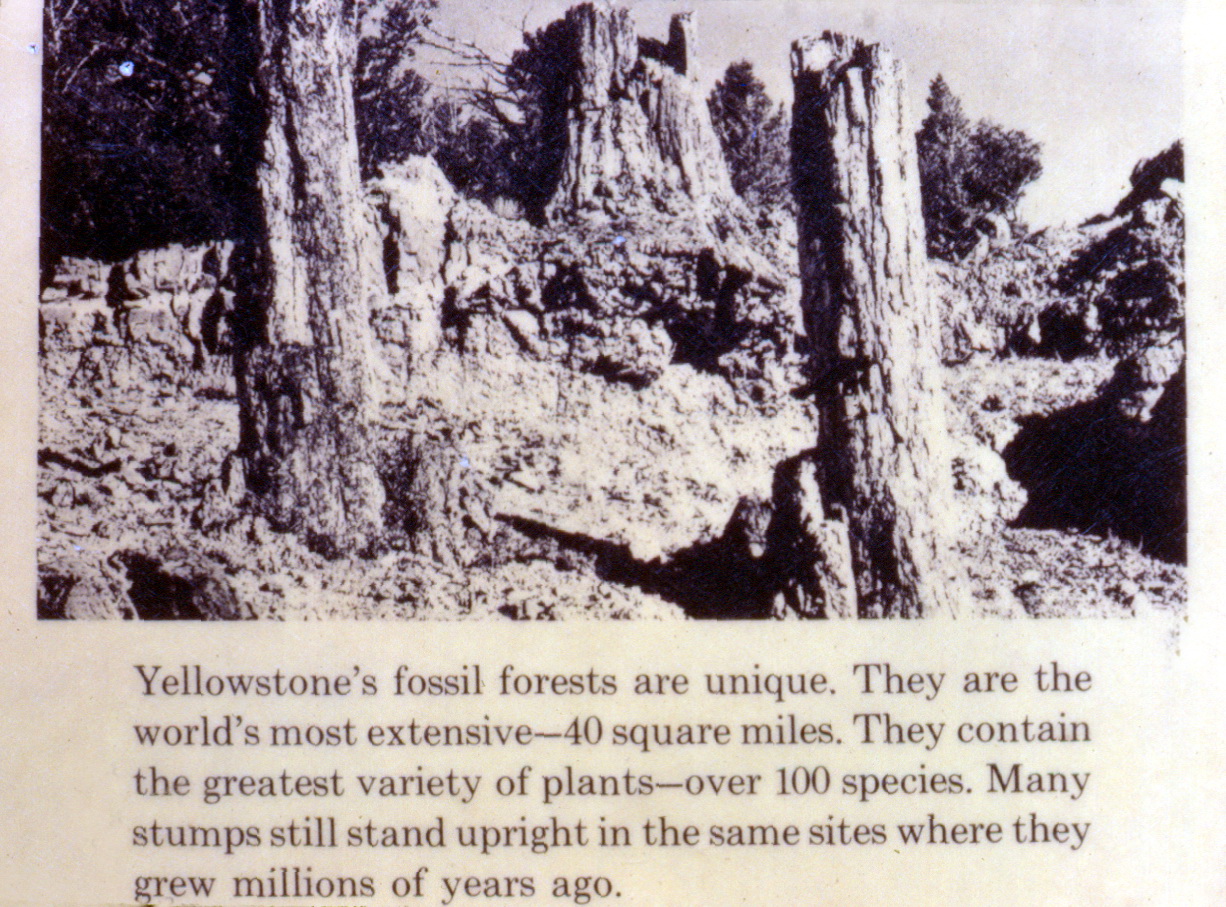
page 479 on the "Upright trunks in carbon sandstone of St. Etienne in France". (Click image to enlarge.)


* These Trees Did Not Grow Here: The old-earth biased National Park Service cannot be trusted when it contradicts biblical chronology. For example, creationists worked to correct the NPS' false claim that Yellowstone's petrified trees grew in up to 50 successive forests, each leaving behind one or more individual trees which became petrified, all of this at Specimen Ridge (and Creek).
* Collectively, they form a Polystrate Fossil Forest: Creationists have worked hard to correct the historical record. Yellowstone's petrified trees lack root systems. So, they do not stand where they grew. Instead, they were all deposited during a catastrophic event that was rapidly laying down a wet sediments (which lithified into today's strata). These trees, after getting waterlogged and sinking vertically (upright floaters), settled onto what was, at their moment of settling, the topmost layer. They were then soon buried (in days to months; not millennia) by subsequently deposited sediments, and joined by other trees vertically sinking and settling into the successive layers of sediments that were burying the trees that had sunk just days and weeks previously. Thus, the entire system of the fossil forest forms a single polystrate fossil that compresses the formation event from allegedly tens of thousands of years down to mere months. See this also in RSR's 3-minute YouTube video:

rsr.org/gee and on National Geographic's website and in the CRS Quarterly.

meticulously restored by FOSSILERA, like countless trilobites around the world, was buried in limestone, much of which is said to be deposited very slowly, grain by single grain of calcium carbonate.

Yet thousands of trilobites from countless locations are buried three-dimensionally, 3D, in other words, not flattened like a piece of paper, but having significant thickness that in polystrate fossils spans layers allegedly laid down sequentially over long periods of time. After having viewed perhaps thousands of trilobites from museum collections, private collections, fossil stores, and over the Internet, it appears that there is no evidence of greater erosion of their upper parts as compared to their lower parts. These creatures, regardless of how many layers of fine particles cover their bodies, were buried in a single depositional event, and not gradually. (See RememberTheNautiloids.com for another enormously widespread example of this observation.)
the collection of the Creation Guy John Mackay. Fossils like this one, buried in multiple "varve" layers, which are claimed to be annual depositions, show no erosional patterns that would indicate a gradual burial. The image to the right, and also from John Mackay (used by permission) is of a bone of an extinct vertebrate squid-like creature, a Belemnite. It's a polystrate fossil because like the countless trilobites, nautiloids, and other creatures, it was buried in limestone, much of which was allegedly super slowly deposited.


* Examples of Typical Timeline Collapsing Polystrate Trees:




* Video of Similar Polystrate Trees in Tennessee: By RSR friend David Rives. (Click image to enlarge, and check this out too.)

* An Entire School of Fish in a Limestone/Shale Deposit: When a fossil of an entire school of fish is found in a finely layered deposit, the entire collection forms a single polystrate fossil which disproves any claim of slow deposition.

The species, Erismatopterus levatus, appears to be an allegedly extinct trout-perch. RSR's Bob Enyart studied computer science at Arizona State University (entry level through to coursework in AI) and so notices when ASU researchers make important observations, as here.
They charted the position and heading direction of every single fish. Mizumoto found that if he looked at where the fish were and where they were going, they seemed to obey two rules that live, modern fish schools follow: repulsion from close neighbors (as if to avoid bumping into each other) but attraction to more distant fish (as if to stay together as a school). Their positions didn’t appear to be random.
every four square meters, one nautiloid either lies or stands upright in limestone throughout the park and far beyond. We've long encouraged old-earthers (like with Stephen Meyer on RSR) to keep an eye out for these fossils.
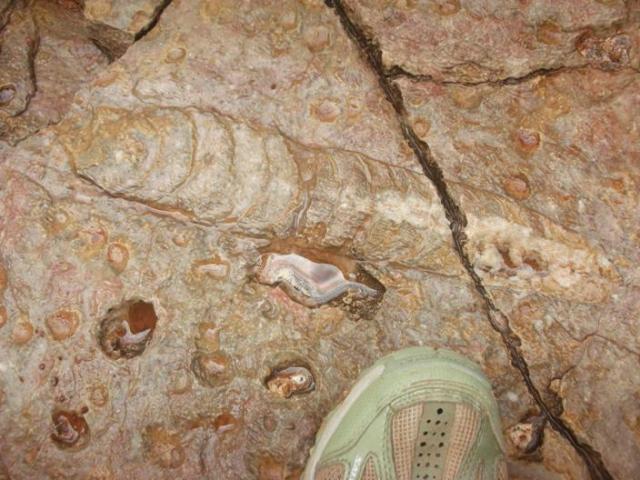
In the Grand Canyon, this basal layer of the Redwall Limestone runs for 277 miles averaging seven feet thick in the east and thickening to about 40 feet as it runs to the west (and beyond, even to Las Vegas). The remains of these creatures distributed over thousands of square miles contradict the standard account for the super-slow formation of limestone. The Redwall allegedly forms at a rate of about 4,000 years per inch. Along with many other dead creatures in this one particular deposit, 15% of these nautiloids were killed and then fossilized standing on their heads. Yes, vertically. Whatever conditions existed at their demise prevented gravity from enabling all of their dead carcasses to fall over on their sides. Of course, these dead creatures would not lay around for 10,000 years on a seafloor waiting to be fossilized, and they certainly wouldn't stand vertically for 80,000 years waiting for the limestone to entomb them. And as seen characteristically at rsr.org/polystrates with even delicate radiating spines and schools of jellyfish permineralized through multiple strata, there is no wear pattern showing greater erosion on the top as compared to the bottom of buried nautiloids and all such fossils, yet again disproving any slow deposition hypothesis. Famed Mount St. Helen's geologist Steve Austin is also the world's leading expert on nautiloid fossils. (See for example Austin's abstract for a Geological Society of America conference titled the Canyon-Length Mass Kill of Orthocone, Nautiloids, Redwall Limestone (Mississippian), Grand Canyon, Arizona which is excerpted at youngearth.com/grand-canyon-nautiloids.) Dr. Austin has worked in the canyon and presented his findings to the park's rangers at the invitation of National Park Service officials. Austin points out, as is true of many of the world's mass fossil graveyards, that this enormous nautiloid deposition provides indisputable proof of the extremely rapid formation of this significant layer of limestone near the bottom of the canyon.
Standard geology teaches students that limestone as at the Grand Canyon forms at the bottom of a shallow and placid sea with slow and gradual sedimentation, often just one grain of calcium carbonate at a time. But a million nautiloids, literally standing on their heads, would beg to differ.
* Two More Areas of Polystrate Interest: As an exercise for the student, figure out burial rates and other standard explanation challenges for the following:
- "The 90 metres of deposit" of the Hell Creek formation "was created in about 2 million years" yet it is filled with three dimensional hadrosaur fossils (which, btw, happened to be loaded with original biological material)!
- The pterosaur (and two fish) fossil (and others) in the Solnhofen Limestone deposit in Germany.
This page is still in draft form. Feel free to send suggestions to Bob@rsr.org. Also, RSR presents some of the above polystrate examples at youngearth.com.
* Bob Enyart's Argument Against Theistic Evolution: as filmed on the Pepperdine University campus at Malibu...
This is the show from Friday, January 24th, 2020
SUMMARY:

Many have heard about polystrate tree fossils, the thousands of trunks found standing upright through multiple rock layers. (Poly means many, strata means geological layer). Many polystrate fossils (see the list below) are claimed to have been buried in layers that are alleged to typically form over many thousands or even a million years. Areas noted for polystrate tree fossils include:
- Joggins in Nova Scotia
- Sydney, Nova Scotia (260 miles from Joggins)
- Lancashire in England
- Germany's Ruhr region
- Specimen Ridge in Yellowstone
- St. Etienne in France.
Google ranks us #2 in searches for:
list of polystrate fossils.
Trees form one kind of polystrate fossil, and this list, as we will see, is not a list just of polystrate fossils, but it's a list of the kinds of polystrate fossils that exist. Regarding the formation of any kind of polystrate, of course, dead organisms cannot stand for thousands of years waiting to be buried. And characteristically such fossils, as with polystrates trees, show no greater erosion at their top than at their base. So a single polystrate fossil compresses the time it took to lay down its burial strata into a relative brief period.
* Textbooks Skip Polystrates: Creationists claim that geology textbooks tend to omit any discussion at all of polystrate fossils. For example, a 2019 list of the top ten current geology textbooks includes Geology: A Complete Introduction. Yet a Google Books search reveals, "No results found in this book for polystrate." And there's The Changing Earth: Exploring Geology and Evolution published by Thomson Learning with offices in Australia, Canada, Spain, the UK, the U.S., Singapore, and Mexico. "No results found in this book for polystrate." Then there's Physical Geology 16th edition published by McGraw-Hill. "From inside the book, Your search - polystrate - did not match any documents." Those titles are searchable online. It appears there is a lack of interest in polystrate fossils among old-earth geologists. Just like with dinosaur soft tissue, which is the greatest discovery in the history of paleontology, scientists and the science media show a lack of interest in polystrates and what those fossils can tell us about the past. So, because evolutionists lack the scientific curiosity, and undoubtedly that's out of a fear of what polystrate fossils may reveal about the geologic record, it takes creationists to explore them, and explore them we will!
* Evolutionary Explanations for Polystrates: Because geology textbooks ignore polystrate fossils, evolutionary explanations have to gleaned from anti-creation sources and from mainstream geology explanations for strata that contain polystrates. So the old-earth explanations include:
E1 Rapid Sedimentation: The layers burying a polystrate are the exceptions, being deposited during a "rapid rate of sedimentation" (e.g., river flooding burying growing trees; see this at NSCE, the site of Bob's opponent Eugenie Scott). That's the correct explanation, except that evolutionists refuse then to follow those layers to see the extent of the rapid deposition, and thus they close their eyes to the verifiable rapid speed of deposition of the geologic column generally!
E2 Persistent Trees: As at Yellowstone's Specimen Ridge where petrified trees stand through multiple strata that were long claimed to make up 50 successive forests, vertically, each growing and dying out, one on top of another, fifty times. Even though the Nat'l Park Service has removed the exhibit that makes that false claim, nonetheless it shows an inherent polystrate explanation, that trees can remain vertically long enough for the passage for sufficient geologic time to see the rise and demise of multiple layers successive forests.
E3 Persistent Organisms with Rapid Sedimentation: A combination of trees, for example, buried by fast sedimentation, followed by and then slow sedimentation. For example from Talk Origins, they suggest an initial burial in sediments of "several feet" followed by continued slower sedimentation or perhaps additional rapid sedimentation events. Trees don't die and decay instantly, so polystrate trees remained upright through a sequence of fast sedimentation followed by slow sedimentation.
E4 Rare Enough to Ignore: Polystrate fossils are extremely rare and mostly a creationist exaggeration so they can be ignored.

Kinds of Polystrate Fossils:
- Upright trees form only one kind of polystrate fossil, other kinds include...
- Polystrate school of jellyfish fossilized across seven layers allegedly deposited over a million-year period
- 171 (awfully persistent dead) tadpoles in diatoms
- Fossilized end-to-end leaves standing on edge
- Aquatic mesosaur reptile in "annual" varves
- A fossilized whale buried in diatoms
- A fossilized school of whales buried across four strata
-

- Nautiloids up to 18 inches in length, thousands buried vertically, for example at the Redwall Limestone which allegedly formed at a rate of about 4,000 years per inch
- A fossilized school of (an allegedly) extinct trout-perch species
- Three-dimensional trilobites in limestone
- Etc. (every one of the millions of fossils that cross strata boundaries)
* Creationist Rebuttals: The old-earth explanations are absurd on their face. Typically, they can't explain a single polystrate let alone the many different kinds of polystrate fossils and the millions of those in existence.
CR1 to Rapid Sedimentation: Even if the earth were billions of years old, secular geologists show an astounding lack of curiosity about polystrates, and by them, which strata could be shown to have been deposited rapidly. Think about the layers that bury such fossils. Those layers don't just extend out only two feet or so from the tree, or from whatever polystrate fossil. We assert, and this could be easily disproved if we were wrong, that the layers that bury and that extend out from each polystrate, as a general rule, go out hundreds or thousands of meters from each fossil, or even 500 kilometers, and more (as with the Redwall Limestone, and so, they extend over thousands of square kilometers). That means that those layers of strata throughout that entire area were deposited rapidly! Shouldn't that interest geologists? And further, some strata layers interleave with neighboring formation layers, like with the edges of some coal seams. So if layers compressed in time by a polystrate fossil happen to interleave with layers of a neighboring formation, then those layers also, in that adjacent formation, had to have been deposited quickly enough to form a polystrate. A single polystrate fossil, potentially, could indicate that an area thousands of square miles had to experience rapid sedimentation. Of course secular geologists, they don't want to know about these polystrates and prefer to believe that such sediments were deposited over millions of years, even if the truth, and the evidence, shows otherwise.
CR2 to Persistent Trees: Trees can't remain upright for thousands or millions of years. Mountains erode faster than evolutionists would have to claim that these trees and nautiloids stood upright, waiting to be buried. And there is often additional evidence that contradicts the slow deposition story, as at Yellowstone where the standard explanation has been falsified in part by our effort here at RSR to expose the truth that the petrified trees there do not have root systems. This shows that these trees were destroyed and transported in a flood event and then waterlogged and sank vertically as flood sediments were settling out of the water. (See that below.) Also, trees are not the only kinds of polystrate fossils. Leaves can't remain upright, that is, vertical, for dozens of years. (See that just below.) A school of fish (below) can't remain frozen in place, all while the allegedly slowly formed strata around them gets deposited layer by layer over years, centuries, millennia, or eons.

CR4 Rare Enough to Ignore: Our RSR list demonstrates that there are many different kinds of polystrates, and when you take all the kinds of polystrates into account, that means that there are many millions, if not billions, of such fossils, showing, like dinosaur soft tissue, that polystrates are not rare but common and appear throughout the fossil record.
* Leaves Buried Vertically in Diatomaceous Rock: Now how about those LEAVES! Leaves? Yes, leaves! There are two leaves, buried vertically, as though standing on edge for thousands of years, while buried by the super-slow deposition of diatomaceous rock! Ha!
Allegedly, diatomaceous earth is evidence of the passage of enormous lengths of time because of its formation from single-cellular diatoms. However, the photo of these delicate polystrate leaves (not unlike an indelicate whale similarly buried in diatoms) demonstrates that diatomaceous sediments can be deposited rapidly.
Then there’s that whale skeleton in a California quarry, uplifted, with its rib cage and other bones buried by diatoms, again, which diatomaceous earth is said to be deposited incredibly slowly!
And speaking of whales, below, we report on the 40 whales buried in Chile!

]

And because jellyfish have no skeleton, as Charles Darwin pointed out, it is rare to find them among fossils. But now, reported in the journal Geology, a school of jellyfish fossils have been found throughout those same seven layers. So, polystrate fossils that condense the time of strata deposition from eons to hours or months, include:
- Jellyfish in central Wisconsin were not deposited and fossilized over a million years but during a single event quick enough to trap a whole school. (This fossil school, therefore, taken as a unit forms a polystrate fossil.) Examples are everywhere that falsify the claims of strata deposition over millions of years.
- A second school of jellyfish, even though they rarely fossilized, exists in another locale with jellyfish fossils in multiple layers, in Australia's Brockman Iron Formation, constraining there too the rate of strata deposition. By the way, jellyfish are an example of evolution's big squeeze. Like galaxies evolving too quickly, galaxy clusters, and even human feet (which, like Mummy DNA, challenge the Out of Africa paradigm), jellyfish have gotten into the act squeezing evolution's timeline, here by 200 million years when they were found in strata allegedly a half-a-billion years old. Other examples, ironically referred to as Medusoid Problematica, are even found in pre-Cambrian strata.

This page began as a segment on RSR's classic List of Not So Old Things at rsr.org/list#jellyfish.]
- Countless trilobites buried in astounding three dimensionality around the world are meticulously recovered from limestone, much of which is claimed to have been deposited very slowly. (See image, RSR's Radtke polystrate trilobite.) Contrariwise, because these specimens were buried rapidly in quickly laid down sediments, they show no evidence of greater erosion on their upper parts as compared to their lower parts.
- 171 tadpoles of the same species buried in diatoms.
- Leaves buried vertically through single-celled diatoms powerfully refute the claimed super-slow deposition of diatomaceous rock.
- Many fossils, including a Mesosaur, have been buried in multiple "varve" layers, which are claimed to be annual depositions, yet they show no erosional patterns that would indicate gradual burial.
- A single whale skeleton preserved in California in dozens of layers of diatom deposits thus forming a polystrate fossil.
- The delicacy of radiating spine polystrates, like tadpole and jellyfish fossils, especially clearly demonstrate the rapidity of such strata deposition.

40 whales buried in the desert in Chile. "What's really interesting is that this didn't just happen once," said Smithsonian evolutionist Dr. Nick Pyenson. It happened four times." Why's that? Because "the fossil site has at least four layers", to which Real Science Radio's Bob Enyart replies: "Ha ha ha ha ha ha ha ha ha ha ha", with RSR co-host Fred Williams thoughtfully adding, "Ha ha!"
polystrate trees:

- Yellowstone's petrified polystrate forest (with the NPS exhibit sign removed; see below) with successive layers of rootless trees demonstrating the rapid deposition of fifty layers of strata.
- A similarly formed polystrate fossil forest in France demonstrating the rapid deposition of a dozen strata.
- In many locations, polystrate fossils such as trees span many strata, including famously in the Fossil Cliffs of Joggins, Nova Scotia, which expose sections of 14,000 vertical feet of sedimentary strata, with 49 out of 50 such trees completely lacking their roots, or containing truncated roots, or roots with their rootlets lopped off, indicating that all of these trees were growing elsewhere and transported here in floodwaters.
- These trees lack erosion: Not only should such fossils, generally speaking, not even exist, but polystrates including trees typically show no evidence of erosion increasing with height. All of this powerfully disproves the claim that the layers were deposited slowly over thousands or millions of years. In the experience of your RSR radio hosts, evolutionists commonly respond to this hard evidence with mocking. See CRSQ June 2006, ICR Impact #316, and RSR 8-11-06 at KGOV.com.

* Yellowstone Exhibit: David Coppedge took these photographs in 1983 in Yellowstone National Park and confirmed to RSR after his 2015 trip that today there are no such signs at Specimen Ridge. Instead, wildlife, etc., exhibits are currently on display there. And near Roosevelt Junction at the fenced-in petrified tree site, the park service presents a sign attributing these tree remains to catastrophic mudflow, which explanation is much closer to reality than their old "successive forests" story. The old, incorrect "Fossil Forest" exhibit claimed that dozens of layers of petrified trees were still standing "where they grew". As explained on Real Science Radio's List of Not So Old Things program, these trees have no root system and were hydraulically transported to their current location. See rsr.org/list#yellowstone. [The second photo below is an RSR composite.]

After Bob Enyart's Trading Genesis theistic evolution presentation (see it below) in May 2015 in Malibu, California on the Pepperdine University campus, David Coppedge wrote to Bob Enyart at Real Science Radio:
"The book Roadside Geology of the Yellowstone Country by [geology professor] William J. Fritz (1985, 6th printing 1994), on pp 25-26, also talks about the change. He says, 'When I visited the Mount St. Helens area shortly after the eruption, it was just like Yellowstone!.... Both the mudflows and the appearance of the trees is identical.' (p. 25). On page 26, though, he points out differences between the two sites. Nice to meet you in person today [Bob]."





page 479 on the "Upright trunks in carbon sandstone of St. Etienne in France". (Click image to enlarge.)


* These Trees Did Not Grow Here: The old-earth biased National Park Service cannot be trusted when it contradicts biblical chronology. For example, creationists worked to correct the NPS' false claim that Yellowstone's petrified trees grew in up to 50 successive forests, each leaving behind one or more individual trees which became petrified, all of this at Specimen Ridge (and Creek).
* Collectively, they form a Polystrate Fossil Forest: Creationists have worked hard to correct the historical record. Yellowstone's petrified trees lack root systems. So, they do not stand where they grew. Instead, they were all deposited during a catastrophic event that was rapidly laying down a wet sediments (which lithified into today's strata). These trees, after getting waterlogged and sinking vertically (upright floaters), settled onto what was, at their moment of settling, the topmost layer. They were then soon buried (in days to months; not millennia) by subsequently deposited sediments, and joined by other trees vertically sinking and settling into the successive layers of sediments that were burying the trees that had sunk just days and weeks previously. Thus, the entire system of the fossil forest forms a single polystrate fossil that compresses the formation event from allegedly tens of thousands of years down to mere months. See this also in RSR's 3-minute YouTube video:

rsr.org/gee and on National Geographic's website and in the CRS Quarterly.

meticulously restored by FOSSILERA, like countless trilobites around the world, was buried in limestone, much of which is said to be deposited very slowly, grain by single grain of calcium carbonate.

Yet thousands of trilobites from countless locations are buried three-dimensionally, 3D, in other words, not flattened like a piece of paper, but having significant thickness that in polystrate fossils spans layers allegedly laid down sequentially over long periods of time. After having viewed perhaps thousands of trilobites from museum collections, private collections, fossil stores, and over the Internet, it appears that there is no evidence of greater erosion of their upper parts as compared to their lower parts. These creatures, regardless of how many layers of fine particles cover their bodies, were buried in a single depositional event, and not gradually. (See RememberTheNautiloids.com for another enormously widespread example of this observation.)
the collection of the Creation Guy John Mackay. Fossils like this one, buried in multiple "varve" layers, which are claimed to be annual depositions, show no erosional patterns that would indicate a gradual burial. The image to the right, and also from John Mackay (used by permission) is of a bone of an extinct vertebrate squid-like creature, a Belemnite. It's a polystrate fossil because like the countless trilobites, nautiloids, and other creatures, it was buried in limestone, much of which was allegedly super slowly deposited.


* Examples of Typical Timeline Collapsing Polystrate Trees:




* Video of Similar Polystrate Trees in Tennessee: By RSR friend David Rives. (Click image to enlarge, and check this out too.)

* An Entire School of Fish in a Limestone/Shale Deposit: When a fossil of an entire school of fish is found in a finely layered deposit, the entire collection forms a single polystrate fossil which disproves any claim of slow deposition.

The species, Erismatopterus levatus, appears to be an allegedly extinct trout-perch. RSR's Bob Enyart studied computer science at Arizona State University (entry level through to coursework in AI) and so notices when ASU researchers make important observations, as here.
They charted the position and heading direction of every single fish. Mizumoto found that if he looked at where the fish were and where they were going, they seemed to obey two rules that live, modern fish schools follow: repulsion from close neighbors (as if to avoid bumping into each other) but attraction to more distant fish (as if to stay together as a school). Their positions didn’t appear to be random.
every four square meters, one nautiloid either lies or stands upright in limestone throughout the park and far beyond. We've long encouraged old-earthers (like with Stephen Meyer on RSR) to keep an eye out for these fossils.

In the Grand Canyon, this basal layer of the Redwall Limestone runs for 277 miles averaging seven feet thick in the east and thickening to about 40 feet as it runs to the west (and beyond, even to Las Vegas). The remains of these creatures distributed over thousands of square miles contradict the standard account for the super-slow formation of limestone. The Redwall allegedly forms at a rate of about 4,000 years per inch. Along with many other dead creatures in this one particular deposit, 15% of these nautiloids were killed and then fossilized standing on their heads. Yes, vertically. Whatever conditions existed at their demise prevented gravity from enabling all of their dead carcasses to fall over on their sides. Of course, these dead creatures would not lay around for 10,000 years on a seafloor waiting to be fossilized, and they certainly wouldn't stand vertically for 80,000 years waiting for the limestone to entomb them. And as seen characteristically at rsr.org/polystrates with even delicate radiating spines and schools of jellyfish permineralized through multiple strata, there is no wear pattern showing greater erosion on the top as compared to the bottom of buried nautiloids and all such fossils, yet again disproving any slow deposition hypothesis. Famed Mount St. Helen's geologist Steve Austin is also the world's leading expert on nautiloid fossils. (See for example Austin's abstract for a Geological Society of America conference titled the Canyon-Length Mass Kill of Orthocone, Nautiloids, Redwall Limestone (Mississippian), Grand Canyon, Arizona which is excerpted at youngearth.com/grand-canyon-nautiloids.) Dr. Austin has worked in the canyon and presented his findings to the park's rangers at the invitation of National Park Service officials. Austin points out, as is true of many of the world's mass fossil graveyards, that this enormous nautiloid deposition provides indisputable proof of the extremely rapid formation of this significant layer of limestone near the bottom of the canyon.
Standard geology teaches students that limestone as at the Grand Canyon forms at the bottom of a shallow and placid sea with slow and gradual sedimentation, often just one grain of calcium carbonate at a time. But a million nautiloids, literally standing on their heads, would beg to differ.
* Two More Areas of Polystrate Interest: As an exercise for the student, figure out burial rates and other standard explanation challenges for the following:
- "The 90 metres of deposit" of the Hell Creek formation "was created in about 2 million years" yet it is filled with three dimensional hadrosaur fossils (which, btw, happened to be loaded with original biological material)!
- The pterosaur (and two fish) fossil (and others) in the Solnhofen Limestone deposit in Germany.
This page is still in draft form. Feel free to send suggestions to Bob@rsr.org. Also, RSR presents some of the above polystrate examples at youngearth.com.
* Bob Enyart's Argument Against Theistic Evolution: as filmed on the Pepperdine University campus at Malibu...
Last edited by a moderator:
